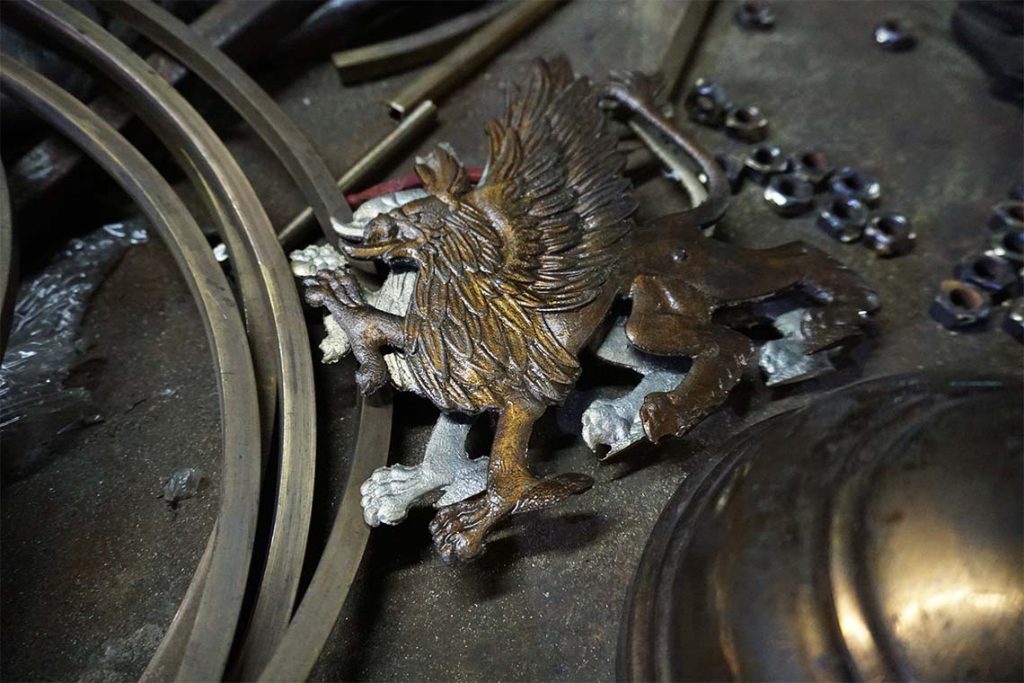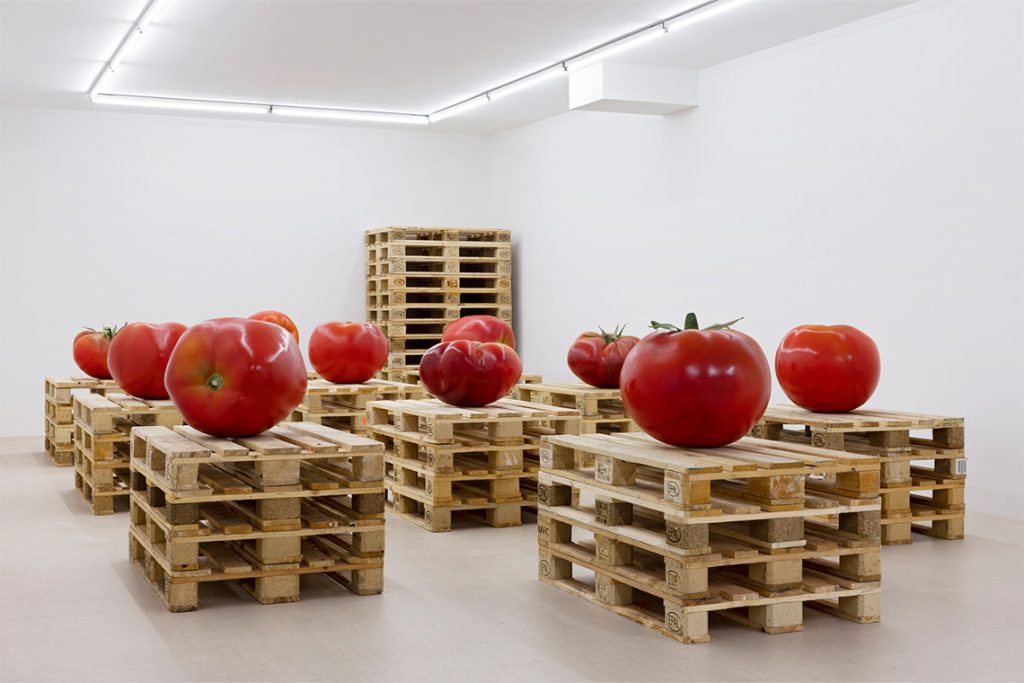The artist digs into her practice, which reconstructs performative and conceptual installations from archival research into Egypt’s historic craft industries.
Canvas: How do you approach the idea of craft in your work?
Yasmine El Meleegy: My practice takes the object as its starting point, and through a sculptural process I unravel the many connotations of production. What I’m trying to do is challenge existing objects, exploring the void between the object, its history and its maker, which is a way of understanding historical and political events. I create monumental installations and artefacts as archaeological sites of the future by reappropriating craft techniques.
How did you first introduce ideas of installation and intervention in your work?
It all started with a moment of retrieval: the repair of a doll gifted to my mother by my father on their wedding day. My mother had a lot of collectibles, a very absurd but fascinating collection containing dolls, tableware sets and small vases, and which has inspired me a lot, especially after her death in 2014.
I then became involved in conceptual notions of repair, in this case as a response to the question, how can we repair something that cannot be repaired? For example, in my project Rites Of Passage (2016–18) I started collecting pieces from my mother’s collection, having hundreds of replicas, digging into industrial moulds and techniques for mass replication, trying to heal from this loss. These objects appeared like archaeological relics of a past, lost in all but memory. All the time I’m trying to push the boundaries of traditional technique, physically and emotionally undergoing a process of trial and error to understand what is repair in personal domestic objects and, on the other hand, what is restoration in a larger space, like the project Scaffolding A Familiar Epoch (2021).
How did Scaffolding A Familiar Epoch combine elements of installation and performance with craft and memory?
This was a site-specific installation involving the renovation of Stephenson Pharmacy in downtown Cairo, which was founded by George Stephenson in 1889, during the British occupation of Egypt, and later purchased by Ehsan Samman and inherited by his son. It reflects a colonial history and aesthetic, caught somewhere between a shop and a museum. Before I started any renovations, I went there and physically cleaned the pharmacy. It became a very intriguing thing for me to enter the private space of the owners and clean it up – it’s somehow a tough and intimate action. It remained a functioning pharmacy at all times, which is why the piece was performative, especially during the pandemic when normal gallery spaces were closed.

I decided to call Scaffolding A Familiar Epoch a performative intervention because it’s all about the physical materiality of my action, with the pharmacy as a whole becoming a new material. It’s more than simply restoring individual glass, wax, concrete or wooden elements; it’s to do with how the space combined science, technique and history into one creation, pushing the boundaries between architectural restoration, physical repair and spiritual healing.
For example, the chandelier is a recreation of the original one. I had to start fabricating one from images and the stories of a gryphon taken from a similar piece in a British pharmacy to speak back to the space’s historical legacy, producing it in collaboration with a specialist chandelier maker in old Cairo. The intervention is not an act based solely on assumptions, but one that questions the notions of personal and collective memory of downtown Cairo and colonial Egypt. This is how reappropriating a site like the pharmacy can speak to the current healthcare system, for example, which is dominated by large-scale production and capitalistic practices that have marginalised the role of the pharmacist.
How do you work with specialist craftspeople?
I like to start the collaboration with them by saying “You are the main character here”, like we are in a theatre setting. It’s very interesting for them to have someone enter their workshop and say, “I’m going to take over your language but also completely accept your experience”. The whole practice of reconstruction relies on their knowledge, which would be lost if artists like myself didn’t engage with them, preserving their legacies in our work like an archive. I think that this kind of conceptual research is truly what I do.

Installation view of The six hundred seventy-four forms and a dragon at For, Basel, 2023. Photography by Gina Folly. © The artist and For
How did you discover the work of the late Egyptian sculptor Fathy Mahmoud?
In Fathy Mahmoud, I found an intriguing line of understudied material history – because there’s not much information about him out there – and one that resonated closely with my practice. I first discovered a porcelain cup in my mother’s collection that carried his signature. This happened only days after I learnt that he was responsible for a series of iconic public statues in Cairo and Alexandria while also establishing a porcelain factory in the mid-20th century. This was a very intense time politically and generated strong opinions about the relationship between artistic production and industry. Mahmoud’s dinnerware sets are found in almost every Egyptian house, a continuation of his vision of ‘Art for Millions’, an ideal he espoused in keeping with the zeitgeist of the post-monarchist Egyptian state. Last year I exhibited part of my research at Gypsum Gallery in To Mend Is To Shatter, my first solo show with the gallery, using the broken remains of porcelain dinnerware sets produced by Mahmoud to create intricate mosaic-inspired artworks. These echo his exploration of the country’s nationalist struggle for independence by presenting destruction and reconstruction in a single gesture.
How did you overlap his approach to craftsmanship with your own in your project A Cup Of Tea With Fathy Mahmoud?
This is an ongoing research project and a published book with the same title. The book moved beyond the notion of an artist book as an art object to create and share alternative knowledge that foregrounds intimate aesthetic inquiry. I use fictioning, speculation and experimentation to reconstruct a personal, as well as social, history from the perspective of an artist’s life. A series of 13 fictional letters that I wrote to Fathy Mahmoud between 2019 and 2022 show my search for what is left of his artworks, the porcelain plates and cups he produced and the factories he founded, particularly in terms of the relationship to craft and the audience. It also questions art’s relationship to power and how this influences its modes of presentation and circulation. As a sculptor myself, I wrote to Mahmoud from a space of vulnerability and understanding, crossing generational, political and social boundaries. The intimate format of the letter allowed me to bend text that weaves fact and fiction to narrate a possible history and to trace aborted dreams.
Why is the idea of industry and mass-production so important to you?
The aesthetics and history of industry are right at the forefront of my mind. The link between the mass consumption of art and craft objects are industrial production methods, which I reference in my Future Farms (Organic) (2023) installation for my recent show The six hundred seventy-four forms and a dragon at For space in Basel. I shaped three versions of tomatoes from fibreglass, tracking the different seasonal shapes that appeared in the market over the years. The heirloom-shaped one is famous these days because it’s jumped up to a very high price, so this has really become a study of the markets through abstract sculptures of tomatoes. The fact they’re fibreglass also represents Egyptian commercial thinking, tracing the industrial material through an ostensibly organic work. I used organic corn leaves for the tomatoes’ own leaves, so you cannot really tell it’s fake. The space all smelled of corn.
This interview first appeared in Canvas 111: Crafting the Contemporary



